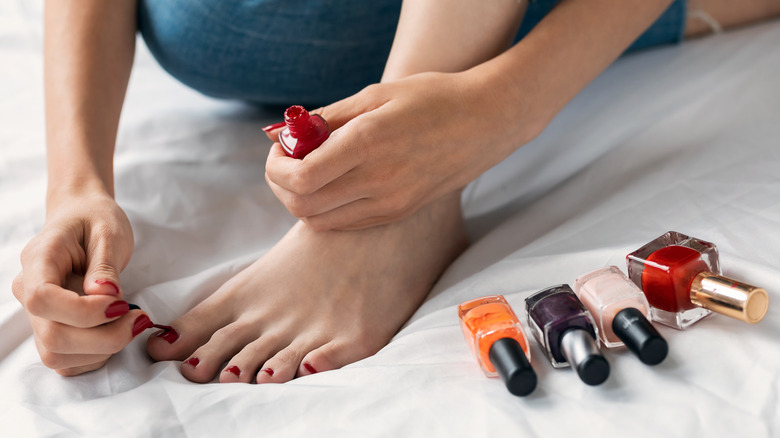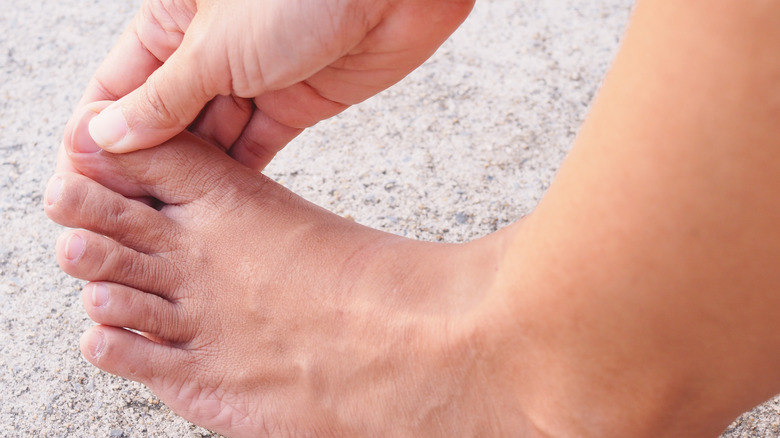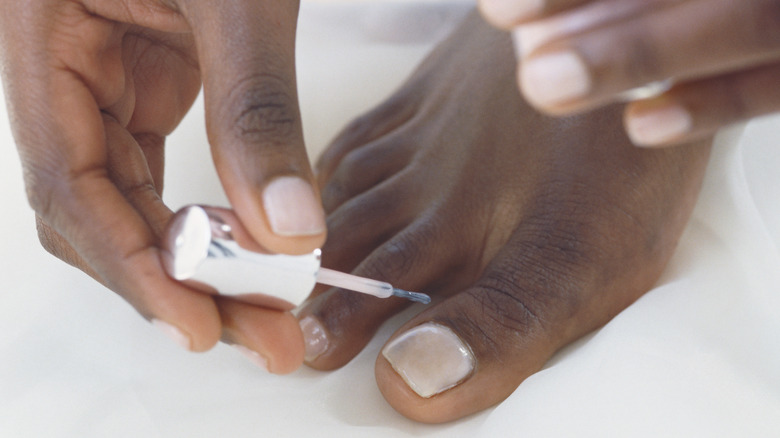Can You Wear Nail Polish If You Have Nail Fungus?
Many people have experienced the frustrating infection that is nail fungus, which is estimated to affect roughly 14% of the population (via U.S. Centers for Disease Control and Prevention).
Once the nail is infected, nail fungus — otherwise referred to as "onychomycosis" — likes to stick around. At the onset of infection, one may not notice anything more than a spot of discoloration on the nail tip, reports the Mayo Clinic. Over time, however, patients may experience thickening of the nail, crumbling, continued discoloration, a smell, or a nail that starts to lift from the nailbed. More often than not, nail fungus tends to develop more easily on the toenails.
Older adults, those with a history of athlete's foot, individuals with diabetes or compromised immunity, or those with certain skin conditions may be at an increased risk for nail fungus. Additional factors such as incurring a minor skin or nail injury, walking barefoot in moist environments, or wearing shoes that don't allow for proper ventilation can also make one more susceptible to the condition.
Nail polish may worsen nail fungus infections
While not always painful, nail fungus infections can still be a cosmetic concern for patients. This can make upcoming events such as weddings, beach trips, or spa outings rather uncomfortable, as revealing our fingernails and toenails may be inevitable in such cases.
Understandably, you may reach for your favorite nail polish to temporarily cover up the problem. However, experts caution that this may only exacerbate the condition. If your nail is already being treated with a topical medication, wearing nail polish is generally not advised. The reason is that the nail polish will act as a sealant, keeping moisture confined within the nailbed (via Cleveland Clinic). This creates an optimal environment for continued fungal growth.
Even more, keeping a coat of nail polish on your infected nails all day every day indefinitely can also worsen the infection. Foot specialist Joy Rowland told Drugs.com that doing so can cause the nail to progressively absorb the pigment, particularly darker shades of nail polish. Not only is this a recipe for discoloration, but it can also cause one's nails to become dry, further enabling fungal growth.
What about antifungal nail polish?
So does this mean that wearing nail polish is entirely out of the question when it comes to nail fungus infections? Not necessarily. If you find yourself with no other choice and nail polish is your only option, try to wear it for as little time as possible. For example, if you're attending a wedding and will be sporting open-toed shoes, try and remember to remove the nail polish right after the event.
By now you might be thinking, what about anti-fungal nail polish? Unfortunately, these products aren't advised as a long-term solution either. "They provide a better environment than general nail polish, but don't use them for treatment and remove [it] as soon as you get home," Jane Anderson, a spokesperson for the American Podiatric Medical Association, told Prevention.
Of course, we're only human, and it's possible that nail polish removal may slip our minds and remain on for a few more weeks than intended. In this event, Joy Rowland told Drugs.com, the best thing to do is to balance it out with several weeks of nail polish-free toes in order to give the nail ample air exposure.
If you detect potential signs of nail fungus, be sure to speak with a podiatrist, as prescription medications or other treatments may be required to help clear the infection.



